
français en
musique
sections on this page:
français en musique
philosophy
The program mainly sees the computer working as a tool. Some of the exercises, such as the essay written for the Bruel package, could arguably be equally well presented on paper but the program adds the ability to read the lyrics at the same time as hearing the words pronounced and, furthermore, vocabulary can be researched by the individual user, which saves the teacher having to go over words which might be understood already by 75% of the class. Other exercises are more interactive, such as the self-marking JavaScript-based exercise for the Cabrel and Piaf songs.
design
The FeM program has turned out much as was set out in the Design Specifications. The basic pages are written principally in HTML and it is distributed on CD-ROM, although I am also planning to make it available via the CUDN from the shared files area on my computer (dnas2.girton.cam), when I am present, for people with the password. This is an experimental function aimed at finding out about optimum file-sizes for network-based distribution of future projects. The HTML files are displayed in a smaller window to allow for different screen resolutions and IFRAMES have been used to keep the layout simple. The only major change from the original plan is that the number of songs used has been reduced form twelve to eight, due to limitations on time. Nevertheless, all of the technologies I had wanted to demonstrate (and more besides) have been covered.
As discussed in the Design Specifications, the music is a mixture of RealAudio format (allowing a small file to contain an entire song and making it realistic for the program to be networked, for example) and Wave format (allowing random-access, as shown principally in the Pagny exercise). Both the RealPlayer and Windows Media Player are embedded with an Active X control which, although it severely limits the majority users of the program to MS Windows users, does avoid having many windows open on the screen at any one time, which could lead to confusion.
Another feature which has been implemented as envisaged originally is that hovering the mouse over a difficult word gives a translation in the Status Bar at the foot of the browser, thanks to a bit of JavaScript. Of course, this could be extended to include every word but I do not believe that the pedagogical value would be so great and also file sizes would be substantially bigger this way, making it unsuitable for internet-based use. Time restrictions meant that the full vocabulary with pronunciation, as found in the Cabrel exercise, could not be created for every song but this would be a possible extension of the project.
The project claims to be compatible with Netscape Navigator 6 but MIE 6 must be strongly recommended. The necessary Active X controls do not ship with Netscape and so must be downloaded from Netscape's website, although the browser will offer to do this for you. Failing to do this, will result in a screen similar to that below:
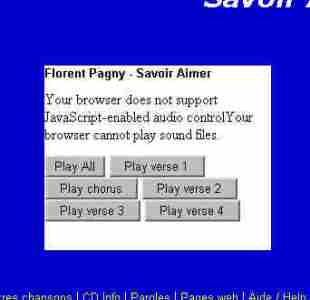
...and don't even think about trying it in Netscape 2 - it doesn't support the IFRAME, nor CSS (and so links end up as blue on a blue background) and the result is more than likely to be this:
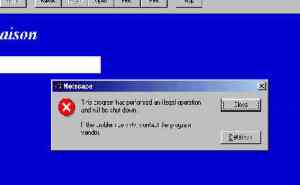
The colour scheme of white text on a blue background with yellow links was designed to appear informal without risking fonts such as Comic Sans MS, which I would see as far too informal for educational software. It should also be suitable for partially-sighted students. By running in the web-browser, this latter category of people can also take advantages of MIE's very customisable accessibility settings to make the program appear best to them. The main content is black on white, since the high level of contrast makes it easier to read this text. Some might argue that the text is too small but it was the only way to keep the lyrics in their lines within the constraints of the IFRAME which certainly simplified the layout. (Had the IFRAME not been used, the only other easy way of implementing the design would have been server-side includes in an internet-based design, which Thor does not currently have enabled).
technologies
As had already been mentioned, the principal technology used is HTML, as used on the World Wide Web. HTML 4.01 was chosen as it is most widely supported on recent browsers and also allowed some development in Dreamweaver 2, which does not recognise XHTML.
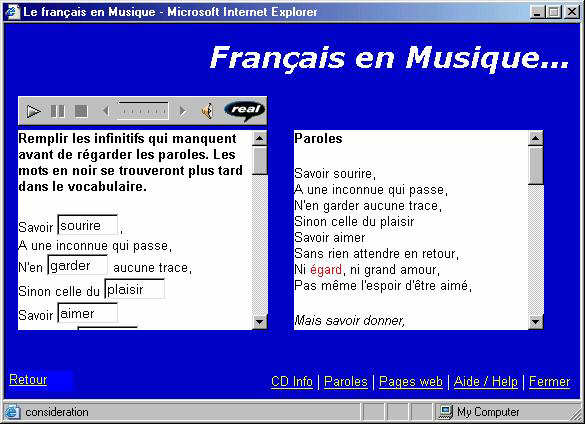
JavaScript also plays a major rôle, in that the exercises for the Cabrel and Piaf songs are almost entirely written in the language and were adapted by myself from a quiz script freely available on the javascript.internet website. My own attempt at JavaScript writing is the second half of the Hallyday exercise, and fuller details of this can be found in the source code for hallyday-qu.htm. The JavaScript which allows the individual verses in the Pagny exercise to be played was also put together myself, based on three individual scripts I found on the internet which allowed for some sound to start and stop at given points.
SMIL, and its derivative RealText, has been implemented in the design of the Bruel exercise. Whilst this does place fairly stringent requirements on the minimum specifications, I felt that this represents the way the internet-based CALL software could go in the future and so I was keen to try my hand at it. Somewhat surprisingly, I found that (once I had read the developer's information on the RealNetworks website) the most difficult aspect of the creation of the SMIL was not the language (which is XML-based) but trying to get the song lyrics to display while the words were being sung. This took several hours and was eventually solved by using lines of white text to give the correct spacing between the verses which were displayed in black. This difficulty had then to be faced again when I created the vocabulary for the bottom area.
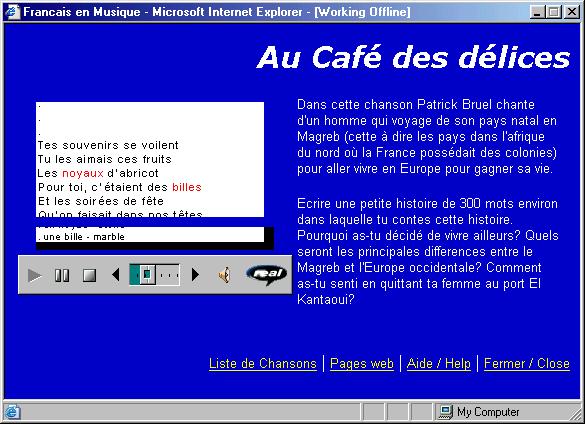
ease-of-use
I hope that users will find FeM easy to use. A full help file is included, which has been made to look like standard Windows Help, to make it even easier to use. This help file is also written in both French and English, to make life easier for anybody with little knowledge of the target language. Having said this, I hope that it should not be necessary for a user to view the Help, since instructions are given on every page and the menu uses no icons (only whole words) which could make things less clear.
To allow future ease-of-use, all of these web-based pages are now mirrored via my homepage (domsmith.co.uk) so they will still be accessible long after my account is removed from Thor.
in the classroom
As the program was nearing completion, I showed it to an ex-French teacher, to ask if he would comment on his experiences of using CALL in the classroom. He stressed two major potential advantages: CALL software allows teachers to supervise the children more closely, as there is no need to try to motivate an entire class all of the time, as is often the case in the traditional classroom setting. Linked to this is the theme of self-motivation: pupils are often very keen to use computers and will be motivated to complete the activity often just because it is presented on a screen, rather than a book.
The main disadvantage he mentioned is that there us great potential for time-wasting and pupils on computers may well try to spin-out an exercise that should only require ten minutes to take half-an-hour or more. As a result of these comments, I experimentally included a time-out feature with the Piaf exercise: after five minutes, a warning is displayed warning that there are only ten minutes remaining in which to complete the activity and, after a further ten minutes, the user finds themselves returned to the list of songs. Of course, some people using the program sensibly may not like this feature but I think that a total of fifteen minutes on a grammar exercise such as this, is more than sufficient. It is for this reason that I believe that CALL has still to be taken advantage of fully in the classroom: teachers seem to prefer the Bruel-type of exercise which uses the computer as a stimulus (allowing children to complete the task at their normal desks), rather than the Cabrel-type of computer based grammar exercise with no time limit.
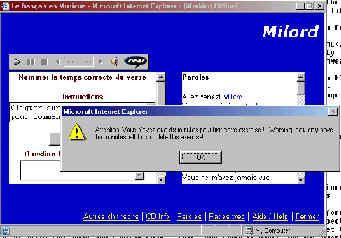
extensions
Recent visits to two local schools have now conviced me of the need for CALL software to cater for the old-tech market too. Both languages depatrments I visited contained many BBC Master Bs and Acorns (mainly A3000/A5000s but some RISC PCs as well). The BBC Basic version mentioned in the specifications has, therefore, now been completed and the source code is available here. It replicates the grammar exercise for the Pagny song but only for the first verse - which extends to 91 lines of code as it is! JavaScript is certainly far more efficient but I enjoyed being able to use BASIC again, since it was my first real experience of computing. If you have a BBC Basic emulator on a PC, simply remove the .txt from the full filename pagny.bas.txt - if you are using a BBC Master B, etc, you will have to retype the source code, as per computer magazines of old! Sadly, neither my trusty A4000 nor the RISC OS emulator on my PC will allow me to produce a screendump of a BBC BASIC program, but I do promise that it works, at least under BASIC version 4 (I don't have access to earlier machines to test it under previous incarnations). As I said in the design specifications, I do not plan to do any more work on this BASIC version but the code should be simple enough for anybody with a reasonable knowledge of the language to improve and continue it, if they wished. I had to stop my version at the first verse as I was already starting to run out of spare variables, something which any future designer would have to correct. It could also be improved by highlighting incorrect words, something which it cannot currently do.
Ideally, I would have liked to include more songs and exercises and to have used more SMIL. It was also planned to allow users writing essays as a result of the Bruel exercise, for example, to submit them via a web-form to be displayed on a web site but the lack of CGI support on the Thor Apache webserver thwarted this idea.
conclusion
I have found it very fun and challenging producing this program and it has even given me an excuse to visit the technical pages of the RealNetworks site, looking for some unknown feature of SMIL! Time limitations have, admittedly, resulted in me having to scale back the project slightly but I have still been able to implement and demonstrate all of the technologies I had originally wanted to. Of course, it would be illegal to distribute the program in its current form, due to copyright restrictions, but I hope that others would find it useful if they could be given access to it.
© Dominic Smith
Email: dom@domsmith.co.uk
Trademarks acknowledged.